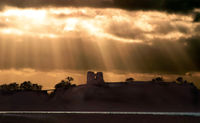
Kalø slot
Encyclopedia


Castle
A castle is a type of fortified structure built in Europe and the Middle East during the Middle Ages by European nobility. Scholars debate the scope of the word castle, but usually consider it to be the private fortified residence of a lord or noble...
located in eastern Jutland
Jutland
Jutland , historically also called Cimbria, is the name of the peninsula that juts out in Northern Europe toward the rest of Scandinavia, forming the mainland part of Denmark. It has the North Sea to its west, Kattegat and Skagerrak to its north, the Baltic Sea to its east, and the Danish–German...
, in Denmark
Denmark
Denmark is a Scandinavian country in Northern Europe. The countries of Denmark and Greenland, as well as the Faroe Islands, constitute the Kingdom of Denmark . It is the southernmost of the Nordic countries, southwest of Sweden and south of Norway, and bordered to the south by Germany. Denmark...
. The castle was founded in 1313 by the Danish king Erik Menved
Eric VI of Denmark
Eric VI Menved was King of Denmark and a son of Eric V and Agnes of Brandenburg.He became king in 1286 at age 12, when his father was murdered 20 November by unknown assailants...
in order to establish a stronghold in northern Jutland
Jutland
Jutland , historically also called Cimbria, is the name of the peninsula that juts out in Northern Europe toward the rest of Scandinavia, forming the mainland part of Denmark. It has the North Sea to its west, Kattegat and Skagerrak to its north, the Baltic Sea to its east, and the Danish–German...
to counter the ongoing rebellions by the local nobility and peasants against the crown. The castle was successful and from the 15th century and onwards the castle had a more peaceful role as the local administrative center. King Christian II held the future Swedish king Gustav Vasa captive at Kalø during 1518-1519, until he escaped.
When king Frederick III
Frederick III of Denmark
Frederick III was king of Denmark and Norway from 1648 until his death. He instituted absolute monarchy in Denmark and Norway in 1660, confirmed by law in 1665 as the first in western historiography. He was born the second-eldest son of Christian IV of Denmark and Anne Catherine of Brandenburg...
converted the elective monarchy
Elective monarchy
An elective monarchy is a monarchy ruled by an elected rather than hereditary monarch. The manner of election, the nature of the candidacy and the electors vary from case to case...
into an absolute monarchy
Absolute monarchy
Absolute monarchy is a monarchical form of government in which the monarch exercises ultimate governing authority as head of state and head of government, his or her power not being limited by a constitution or by the law. An absolute monarch thus wields unrestricted political power over the...
by the revolution of 1660 in Denmark
Denmark
Denmark is a Scandinavian country in Northern Europe. The countries of Denmark and Greenland, as well as the Faroe Islands, constitute the Kingdom of Denmark . It is the southernmost of the Nordic countries, southwest of Sweden and south of Norway, and bordered to the south by Germany. Denmark...
, the castle lost its function.
In 1661, Frederick III gave Kalø Slot to Ulrik Frederik Gyldenløve
Ulrik Frederik Gyldenløve, Count of Laurvig
Ulrik Frederik Gyldenløve, Count of Laurvig was a statesman and the leading Norwegian general in the Scanian War, whose Norway-related portion is conventionally named "the Gyldenløve War", after him...
, who in the following year (1662), tore down the now abandoned castle. The material was used to build his private palace in Copenhagen
Copenhagen
Copenhagen is the capital and largest city of Denmark, with an urban population of 1,199,224 and a metropolitan population of 1,930,260 . With the completion of the transnational Øresund Bridge in 2000, Copenhagen has become the centre of the increasingly integrating Øresund Region...
, now called the Charlottenborg Palace
Charlottenborg Palace
Charlottenborg Palace is a large town mansion located on the corner of Kongens Nytorv and Nyhavn in Copenhagen, Denmark. Originally built as a residence for Ulrik Frederik Gyldenløve, it has served as the base of the Royal Danish Academy of Fine Arts since its foundation in 1754...
.
Today the castle ruin is owned by the Danish State.

